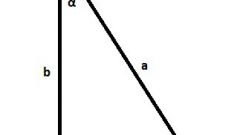Instruction
1
If the length of one of the legs (a) and the hypotenuse (C) of a right triangle are known, calculate the length of the third side (b) the Pythagorean theorem. It follows that the required value must be equal to the square root of the difference between the squared length of the hypotenuse and the square of the length of the known leg: b = √(c2-a2).
2
Knowing the measure of the angle (α) at the vertex of the triangle lying opposite the side of known length (a), it is also possible to calculate the unknown length of the second leg (b). To do this, apply the definition of trigonometric functions - tangent for acute angle. It implies that the desired length of leg should be equal to the size of the known side divided by the tangent of the opposite angle: b = a/tg(α).
3
The definition of cotangent for an acute angle use to find the length of side (b) in the event that if in the conditions of the given angle value (β), attached to another leg of known length (a). The formula in General will look almost the same as in the previous step, replace it with only the function name and designation of the angle: b = a/ctg(β).
4
At a known length of the hypotenuse (c) in the calculation of the size of the leg (b) use the definitions of the basic trigonometric functions - sine and cosine for acute angles. If the conditions given, the angle (α) between the two sides of the two functions, should choose the cosine. Multiply the length of the hypotenuse the cosine of the known angle: b = c*cos(α).
5
Definition of sine for acute angles use in cases when, besides the length of the hypotenuse (c) is given the value of the angle (β) at the vertex lying opposite the required side (b). The formula in General will be similar to the previous one - it must contain the product of the length of the hypotenuse to the sine of the angle specified value: b = c*sin(β).




